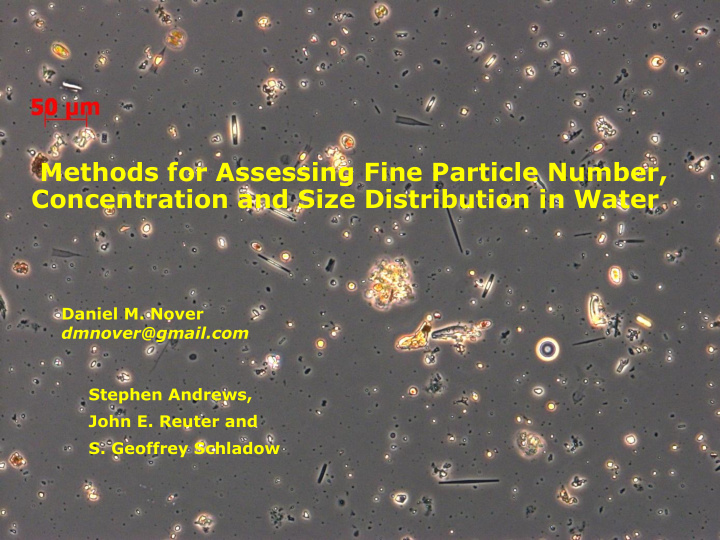



Methods for Assessing Fine Particle Number, Concentration and Size Distribution in Water Daniel M. Nover dmnover@gmail.com Stephen Andrews, John E. Reuter and S. Geoffrey Schladow
From now on we live in a world where man has walked on the moon. It’s not a miracle; we just decided to go. -Tom Hanks
What’s a particle? Inorganic Particles Organic Particles Winder 2009
Why do I care about particles? Jassby, A. D. et al. 1994 Swift, T. J., et al. 2006 From Swift 2004
Measuring Particle Size Distribution LS-200 and LiQuilaz -S05-HF System (Particle Measuring Systems, 1993) From Rabidoux 2005
What’s the deal with Lake Tahoe Particles? Swift, T.J. 2004
Long Term Monitoring
What methods can we use to measure fine particles (<20 m m diameter) in CLEAN lake water? How do differences in instruments and differences in particles influence particle size and number data? How do particle attributes influence results?
Instrumentation Instruments LiQuilaz LISST-100X MoFlow Cytometer Light Microscope Spatial Resolution Poor Excellent Poor Poor Temporal Resolution Poor Excellent Poor Poor Range 0.5-20 µm 1.25-250 µm 0.1-20 µm Wide Special Feature Low range In-situ Absolute counts Accuracy?
Particles Considered P. fluorescens Washoe County Road Dust Glass and PS Beads S. elongatus Marla Bay(0m) F. crotonensis C. reinhardtii A. formosa
2 m m 2.5 m m 5 m m 8 m m Glass Beads
Ellipsoid Bacterium ~0.5 m m Diameter P. fluorescens
Elipsoid Cyanobacterium ~2 m m Diameter S. elongatus
Spherical Chlorophyte ~5 m m Diameter C. reinhardtii
Organic non-conformists F. crotonensis A. formosa
Washoe County Road Dust
Washoe County Road Dust and S. elongatus
Marla Bay (0m), Lake Tahoe, CA-NV
LISST LiQuilaz Cytometer A 1.E+06 2 m m 5 m m Instruments #/mL 1.E+05 2.5 m m 1.E+04 8 m m 1.E+03 1.E+02 1.E+03 1.E+04 1.E+05 1.E+06 Microscope #/mL 1.E+08 B 1.E+07 S. elongatus Instruments #/mL 1.E+06 P. fluorescens 1.E+05 1.E+04 C. reinhardtii 1.E+03 1.E+03 1.E+05 1.E+07 Microscope #/mL C 1.E+07 Road 1.E+06 Dust Instruments #/mL 1.E+05 S. elongatus 1.E+04 +Road Dust Lake Water 1.E+03 1.E+04 1.E+05 1.E+06 1.E+07 Microscope #/mL
Conclusions All particle counting methods introduce error The “real” PSD is hard to know Despite differences, PSD estimates need not hinder management because measurement error is sufficiently small.
Acknowledgements Field Sampling and Laboratory Assistance: Brant Allen, Ann Liston, Monika Winder, and Debbie Hunter Graduate and Undergraduate Students: Jenny Coker, Banu Sunman, Alex Rabidoux, David Jassby, Rachel Terpstra, Todd Steissberg, Laura Doyle and Kristin Reardon This research was supported by an agreement from the USDA Forest Service Pacific Southwest Research Station This research was supported in part using funds provided by the Bureau of Land Management through the sale of public lands as authorized by the Southern Nevada Public Land Management Act.
Questions? Before I came here I was confused about the subject. Having listened to your lecture I am still confused. But on a higher level. - Enrico Fermi
Recommend
More recommend